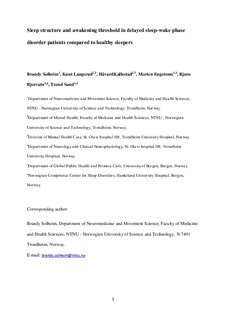Sleep structure and awakening threshold in delayed sleep-wake phase disorder patients compared to healthy sleepers
Journal article, Peer reviewed
Accepted version

Åpne
Permanent lenke
http://hdl.handle.net/11250/2596338Utgivelsesdato
2018Metadata
Vis full innførselSamlinger
Sammendrag
Study Objectives
Difficult early morning awakening is a primary symptom of delayed sleep-wake phase disorder (DSWPD), however, it remains poorly investigated. Our main objective was to quantify the awakening threshold in DSWPD-patients and healthy controls as well as investigate a possible relationship with sleep stages. A secondary objective was to compare habitual sleep measured by polysomnography and actigraphy between patients and controls.
Methods
Twenty DSWPD patients and 16 controls had two polysomnographic recordings at a sleep laboratory. Participants followed their habitual sleep-wake schedule on the first night and a forced sleep-wake schedule (00:00–07:00 h) on the second night. We used a custom-made alarm clock was for the forced-night awakening, starting at 72 dB sound intensity which increased up to 104 dB.
Results
Mean awakening threshold in dB was higher in patients compared to controls; 75.5 vs. 72.6, p = 0.01, and the difference could not be explained statistically by sleep-time. Patients who were in REM sleep upon attempted awakening had a higher awakening threshold compared to patients who were in NREM sleep; 80.0 vs 74.7, F = 6.4, p = 0.02. Patients had increased sleep onset latency both at home with actigraphy and by PSG during the first laboratory night (20.6 vs 12.1 min, p = 0.004), however no further differences between the groups were observed regarding sleep structure.
Conclusions
A high early-morning forced awakening threshold in DSWPD was related to REM sleep. Sleep onset problems, even with habitual bedtimes, may also be an integral feature of DSWPD.